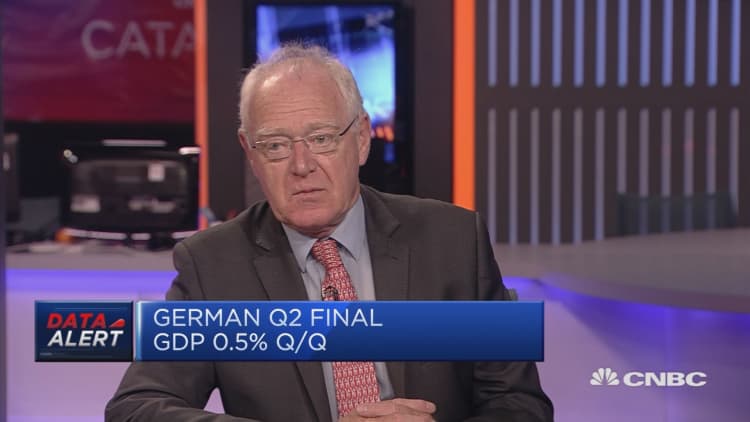While the dollar is set for its biggest weekly decline since March, one strategist said Friday that the dollar strength story is nearing its end.
"I think there's a very high probability that we're in the end game of dollar strength against most currencies," Bob Parker, investment committee member at Quilvest Wealth Management told CNBC's "Squawk Box Europe" on Friday.
Parker, speaking ahead of a speech by Federal Reserve Chair Jerome Powell, added that markets will be looking forward to what the Fed does next year.
"Are they going to do three next year? I think that one thing that is inconsistent is the Fed giving guidance for three rate hikes next year and forecasting growth next year in America of 2.4 percent. Something's not right there."

Parker thinks the U.S. economy could certainly slow down in 2019.
"At a time when European growth is holding close to 2.3, 2.4 percent and the long dollar trade is actually a very concentrated trade at the moment, you can easily see a situation where most currencies turn around more positively against the dollar for next year."
The dollar fell Friday, heading for its biggest weekly decline since March, as investors braced for hints on the course of monetary policy from Fed chair Powell at the annual meeting of central bankers in Jackson Hole, Wyoming.
The greenback rallied Thursday on the back of the latest round of tariffs in the U.S.-China trade conflict and minutes from the most recent Fed meeting that hinted at a September rate hike.
However, this was short-lived as the global currency came under pressure amid growing political uncertainty in the U.S. after two of President Donald Trump's ex-advisors were criminally convicted.
Mike Bell, investment strategist at J.P. Morgan Asset Management, told CNBC on Friday that there are factors pulling in both directions making the dollar hard to call.
"On a rate differential basis, you'd expect further dollar strength. On the other hand, you've got a U.S. economy that has got a fiscal deficit that is pretty large at a late cycle stage for the economy, obviously with the potential for that to deteriorate further eventually, when the economy comes into a difficult period."
The dollar index, which measures the greenback's performance against six major currencies, was down 0.2 percent, trading around 95.5. Since the start of the year, the dollar index is up 3.6 percent.
Stronger dollar, weaker EM?
Meanwhile, the strong dollar also weighed heavily on emerging market (EM) currencies over the last few weeks. However, as the dollar heads for a decline, EM currencies aren't particularly impressed. A number of analysts have attributed this to domestic issues as well as policy paralysis in many countries.
"The dollar finally rose for the first time in seven sessions, which didn't seem to help EM currencies with the added distraction of Mr Trump tweeting that he had instructed Secretary of State Mike Pompeo to 'closely study the South Africa land and farm seizures and expropriations and the large scale killing of farmers,'" Deutsche Bank said in its morning note to clients.
The note pointed out that in response to Trump's tweet, the South African Rand fell -1.71 percent, although Wednesday's inflation numbers also weighed in.
"Elsewhere, the Brazilian real (-1.74 percent) continued to lead losses in EM as investors positioned ahead of this autumn's election. The real is now within 1.5 percent of its weakest-ever level. The Hungarian forint and Turkish lira also weakened -1.02 percent and -1.19 percent versus the dollar, respectively."
Dollar not popular anymore?
While the dollar continues to remain a global currency, the latest data from the International Monetary Fund (IMF) has shown that the greenback's share of currency reserves fell in the first quarter of 2018 to a fresh four-year low, while euro, yuan and sterling's shares of reserves increased.
Central banks across the world hold assets in various currencies to support their liabilities. These reserves have been used by many central banks to help support their respective currencies.
Reserves held in U.S. dollars climbed to $6.499 trillion, or 62.48 percent of allocated reserves, in the first quarter. This compared with $6.282 trillion, or 62.72 percent of allocated reserves, in the fourth quarter of 2017. The share of U.S. dollar reserves contracted to its smallest level since reaching 61.24 percent in the fourth quarter of 2013, IMF data released earlier this year showed.


